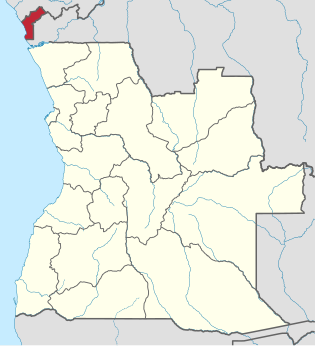1975-present conflict in the Angolan exclave of Cabinda
This article needs to be updated. Please help update this article to reflect recent events or newly available information. (November 2022)
The Cabinda War is an ongoing separatist insurgency, waged by the Front for the Liberation of the Enclave of Cabinda (FLEC) against the government of Angola. FLEC aims at the restoration of the self-proclaimed Republic of Cabinda, located within the borders of the Cabinda province of Angola.
Background
The first Western exploration of the area of modern-day Cabinda was undertaken by navigator Diogo Cão in 1483, later falling under Portuguese influence. In 1853 a delegation of Cabindan chiefs unsuccessfully requested the extension of Portuguese administration from the colony of Angola to Cabinda. Local chiefs continued their attempts at cooperating with Portugal until the 1884 Berlin Conference and the 1885 Treaty of Simulambuco, following which the Cabindan enclave became a Portuguese protectorate. Despite the fact that Cabinda held a semi independent status, a new Portuguese government elected in 1956 transferred the region's administration to Angola without a prior agreement with Cabinda's local leadership.[4]
The first Cabindan separatist movement known as Associação dos Indígenas do Enclave de Cabinda (AlEC) was formed in 1956, AIEC advocated the creation of a union between Cabinda and Belgian Congo or French Congo. Associação dos Ressortissants do Enclave de Cabinda (AREC) was founded in 1959 as humanitarian organisation, AREC was renamed into Freedom Movement for the State of Cabinda (MLEC), shifting its role into a political movement promoting self-determination. The National Action Committee of the Cabindan People (CAUNC) and the Mayombé Alliance (ALLIAMA) joined the growing political scene in the same year. In 1963, MLEC, ALLIAMA and CAUNC merged into the Front for the Liberation of the Enclave of Cabinda (FLEC), which had since been the largest self-determination movement in the region.[4]
On the same year, the Organisation of African Unity declared that Cabinda is an independently governed state with its own independence movement. On 10 January 1967, FLEC formed a government in exile based in the town of Tshela, Zaire. In August 1974, FLEC absorbed the Democratic Union of Cabindan Peoples and the Democratic Party of Cabinda, becoming the sole political organisation in Cabinda.[9]
In January 1975 under pressure from Angolan liberation movements, Portugal accepted Cabinda as part of Angola in the Alvor Agreement where the 3 Angolan independence movements (MPLA, UNITA and FNLA) were present, denying Cabinda the right to self-determination previously granted by the U.N. Chart/Right to Self-determination and the Treaty of Simulambuco. On 1 August 1975, FLEC president Luis Ranque Franque announced the formation of the Republic of Cabinda, an independent state. The MPLA troops controlling the region at the time ignored the statement.[9] In November 1975, Angola gained independence from Portugal, claiming Cabinda as part of its territory. The provisional Cabindan government, led by the FLEC, was overturned. On 8 November 1975, FLEC responded by initiating armed struggle, aiming at creating a separate Cabindan state.[5][10]
Conflict
In the course of the Angolan Civil War, FLEC split into five independent factions. FLEC-Posição Militar (FLEC-PM) was later renamed
into FLEC-Renovada (FLEC-R), FLEC-N'Zita, FLEC-Lubota, União Nacional de Libertação de Cabinda (UNLC) and the Communist Committee of Cabinda. As the war continued the MPLA led government attempted to gain the support of the various FLEC factions and enter negotiations. On the other hand, UNITA rebels directly collaborated with FLEC-FAC, while seeking to broaden its alliance with the group. The above did not stop UNITA from occasionally collaborating with MPLA in anti-FLEC operations. In 2002, the Angolan government signed a peace deal with UNITA officially ending the civil war.[1][11]
Cuba, East Germany and the Soviet Union entered the civil war on MPLA's side in 1975, soon invading Cabinda.[3][6]
According to U.S. intelligence services, France and Belgium allegedly supported FLEC by providing training and financial aid, despite the fact that Zaire remained FLEC's main foreign supporter. FLEC-Renovada received support from a number of US, South African and Japanese right wing organisations as well as the World League for Freedom and Democracy.[4]
In 1956, oil was first discovered in the region; by 1966, Gulf Oil Company began commercial exploitation. The large amounts of revenue generated by oil royalties contributed to the rise of Cabinda's geopolitical significance. By 1970, oil revenues amounted to $16 million and were expected to rise to $32–50 million by 1972. Oil continued to play an important role; by 2011 it represented approximately 86% of the Angolan state's total earnings. The marginalisation of the local population in favor of Portuguese and later Angolan interests played an important role in the rise of separatist militancy in the region.[citation needed]
On 18 July 2006, the Cabinda Forum for Dialogue (FCD) and FLEC-Renovada led by António Bento Bembe signed a second definite cease fire with the Angolan government known as the Memorandum of Understanding for Peace in Cabinda. The event took place in Macabi, Cabinda. The agreement assured Cabinda's status as a part of Angola, provided special economic status and local governance powers to Cabinda, and condemned further acts of insurgency and separatism. The treaty received criticism from Bembe's opponents within the movement. The peace accord marked a sharp decrease in the conflict's intensity.[citation needed]
According to the Unrepresented Nations and Peoples Organization, Cabinda is under military occupation,[12] reinforced in recent times by Angolan forces.[13] This was especially true after the Togo national football team was attacked by the FLEC, when Angola was hosting the 2010 African Cup of Nations. Rebel forces claimed it was a mistake.[14] In 2012, FLEC-FAC announced its readiness to declare a ceasefire and pursue a negotiated resolution to the conflict.[15]
International intervention in the conflict has been limited, with Portugal offering a mediation role and letting the FLEC rule a delegation in Lisbon.[16]
Human Rights Violations
According to a Human Rights Watch report, the Angolan military and secret service have committed a number of human rights violations during the conflict. The report indicates that between September 2007 and March 2009, 38 people were arbitrary detained, tortured, humiliated and later put on trial for alleged security crimes. The arrested included six members of the Angolan military who were charged with desertion and carrying out armed attacks, as well as a former Voice of America journalist, known for his criticism of the government. The detainees were denied contact with legal professionals or their families for prolonged periods of time. The above are considered to be a violation of the International Covenant on Civil and Political Rights.[27][28][29]
A Bertelsmann Stiftung investigation covering the period between 2011 and 2013, indicated that systematic human rights violations have taken place, with journalists, civil rights activists and clergy members receiving harassment after being accused of supporting FLEC.
Reports by Freedom House, Bertelsmann Stiftung and Human Rights Watch also pointed out at violations committed by FLEC.[30]

